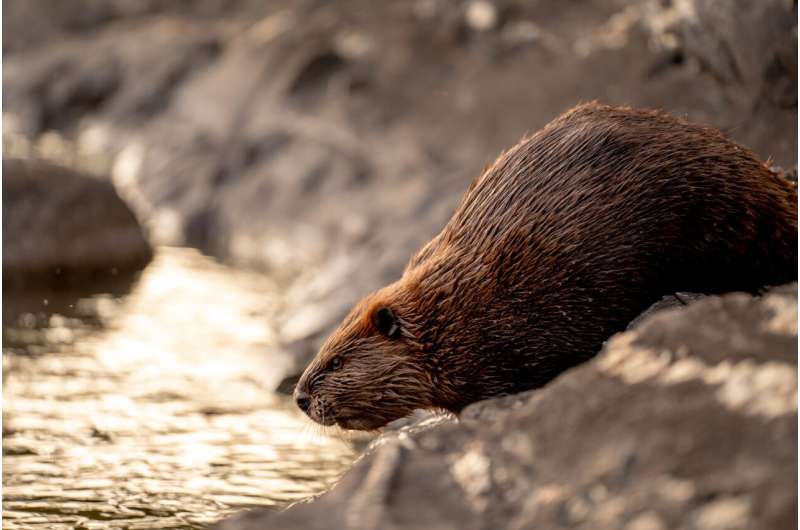Strategically bringing back beavers could support healthy and climate-resilient watersheds

Sadie Harley
scientific editor

Robert Egan
associate editor

After enduring centuries of hunting, habitat loss, and disease, North American beavers (Castor canadensis) are making a comeback—and bringing benefits for both humans and nature with them.
Equipped with findings from a new published in Communications Earth & Environment, a team of researchers from Stanford and the University of Minnesota aims to ensure that beavers return to or establish new homes in areas with the biggest bang for their buck.
The research reveals some of the factors that determine how well beavers can function within a given watershed. The findings could inform decisions about how to manage habitats, wildlife, and waterways.
"Our findings can help land managers figure out where beaver activity will have the biggest impact," said lead study author Luwen Wan, a postdoctoral fellow in Earth system science at the Stanford Doerr School of Sustainability and the Institute for Human-Centered Artificial Intelligence.
"It gives them a practical tool for using nature to solve water and climate problems."
Although beavers often receive a bad reputation when their dams flood a farmer's field or block drainage from a busy highway, their dynamic and rapid dam construction makes them superheroes in natural watershed management.
Beaver dams create cool ponds that foster biodiversity, improve water quality, and even limit the spread of wildfires. They frequently construct multiple dams within an area, creating a wetland network of surface water and vegetation known as "beaver wetland complexes."
These complexes provide long-term freshwater storage and recharge groundwater—a crucial benefit, especially in the American West, where dwindling surface water supplies are the result of years of sustained climate change-driven drought and over-allocation of surface water supplies, as seen in the Upper Colorado River Basin.
"Beavers are naturally doing a lot of the things that we try to do as humans to manage river corridors," said study senior author Kate Maher, a professor of Earth system science at the Stanford Doerr School of Sustainability and a senior fellow at the Woods Institute for the Environment.
"Humans will build one structure, leave it there, and hope it lasts for many decades. Beavers, on the other hand, build little, tiny dams where they're needed and flexibly manage what's going on with the water in their environment."
Maher and Wan collaborated with Emily Fairfax, a beaver expert at the University of Minnesota who has mapped beaver dams through topographic surveys and remote sensing imagery for years. However, traditional surveys in remote areas limit the scale and detail needed to holistically map beaver ponds and their impact on hydrology and ecology. Additionally, dams and ponds are often too small for satellite imagery to capture.
The new study details how the team mapped more than 80 beaver pond complexes across diverse regions in Colorado, Wyoming, Montana, and Oregon using high-resolution aerial imagery from the USDA National Agricultural Imagery Program.
They then identified key factors influencing variations in beaver dam length and pond area.
Their approach allowed the researchers to link pond size to unique landscape features like topography, vegetation, climate, soil characteristics, and stream hydrology. For instance, they found that longer dams were correlated with larger ponds, which in turn could increase ecosystem benefits like cooler local air temperatures and more fish habitat.
Despite the potential for wetland resilience and restoration, beaver activity can create problems for nearby communities. New dams can temporarily reduce water flows, putting stress on downstream water users already struggling to find sufficient surface water supplies during drought conditions. Unmanaged beaver populations can pose a flooding threat to homes, crops, and infrastructure.
"There's definitely a lot of exuberance around reintroducing beavers, and it may not be that every beaver reintroduction project is the right one to pursue," said Maher.
"It's important to understand those trade-offs and the risks and rewards from either intentionally reintroducing beavers, or just their natural return to watersheds."
The team's research highlights the possibility of achieving dual benefits by relocating so-called "nuisance beavers" to watersheds with the capacity to support a beaver population and maximize the natural benefits beavers create.
Wan also notes that the approach could help decision-makers understand the impact of beaver-inspired human structures like beaver dam analogs (BDAs) and other nature-based water management structures.
Moving forward, Wan and Maher are eager to collaborate with Jeannette Bohg, an assistant professor of computer science in the Stanford School of Engineering and co-investigator on the project, to apply machine learning methods to their mapping.
Ultimately, the researchers envision dynamic risk maps that policymakers, watershed managers, and ecologists can use to quantitatively evaluate where, when, and how to bring back beavers.
More information: Factors influencing surface water accumulation in beaver pond complexes across the Western United States, Communications Earth & Environment (2025).
Journal information: Communications Earth & Environment
Provided by Stanford University



















